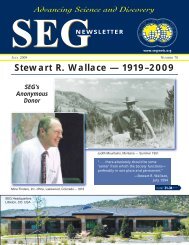Download - Society of Economic Geologists
Download - Society of Economic Geologists
Download - Society of Economic Geologists
You also want an ePaper? Increase the reach of your titles
YUMPU automatically turns print PDFs into web optimized ePapers that Google loves.
6 SEG NEWSLETTER No 65 • APRIL 2006PRESIDENTIAL PERSPECTIVEConnecting with CommunitiesA recent series <strong>of</strong> anti-mining articles inthe New York Times and other U.S. mediaillustrates the problem the mineralsindustry continues to have with widercommunity perceptions <strong>of</strong> its business.This should be a real concern to SEG asa learned society, as two-thirds <strong>of</strong> ourmembers are employed within the miningindustry.Outside the United States, in othercommunities where mining is animportant aspect <strong>of</strong> the economy, weare frequently portrayed as an industrywhich is dirty, distant, and dangerous.Until the recent boom in mineral commodityprices we were regularly cast asa sunset industry whose time was up.It amazes me how these images,mostly the product <strong>of</strong> an earlier era,continue to haunt the modern miningindustry. It shows how easy it is to get abad reputation and how hard it is toturn things around.Today, exploration and mining arehigh technology industries; there havebeen orders <strong>of</strong> magnitude improvementin safety performances over the past 10years, and most miners got their environmentalhouse in order years ago. Inmore remote locations the switch to flyin/fly-outoperations has removed some<strong>of</strong> the disincentives <strong>of</strong> distance. Miningwill rarely be a big-city business, but asa career it by now should haveimproved its appeal to top talent.It is easy for knowledgeable insidersto condemn the crusading nature <strong>of</strong>investigative journalism with its factualerrors and emotive language and wonderat the motives <strong>of</strong> the authors. But inan age when the media is as muchabout entertainment as it is about reliablereporting, this stuff sells newspapersand in the process perpetuates thepopular prejudices and negative stereotypes<strong>of</strong> mining.Why, then, is there this continuingunfortunate public perception? Thereare several reasons, but let me suggestthree.1. Miners and explorers have notalways seen themselves as an integralpart <strong>of</strong> wider society. It is easy for themto work in isolation in remote locationsand have little daily contact with thewider community. They hold strongviews on the economic value they contributeto society but can have anotherwise shallow perception <strong>of</strong> mining’sother social impacts. Remember thebumper stickers “Earth first—we’ll minethe other planets later” or “If it can’t begrown it must be mined”? That level <strong>of</strong>in-your-face intellectual hubris is whatused to pass for community debate.2. Communities nearer to mines perceivethis disdain, too. They ask, notunreasonably, what benefits will flow tothem after the neighborhood is minedout?3. Indigenous communities, stirredup by anti-mining and anti-global nongovernmentalorganizations, and nowlinked globally to the internet, havewaged very effective media campaignsagainst miners large and small. Theviewpoint <strong>of</strong> responsible miners can belost in the clamor.Since the Mining, Minerals andSustainable Development project firstgalvanized the world’s leading miningcompanies in 2001, the notion <strong>of</strong> leavingsomething sustainable after miningis over has gathered widening support.Sustainable development is what communitiesare now demanding, and leadingcompanies are seeing that engagingconstructively with their communitystakeholders is not only the right thingto do but also makes smart businesssense, as well. This is probably the bestopportunity for miners to win back theircredibility with the wider community.What Can SEG Members Do?Developing improved community attitudesand awareness requires the commitment<strong>of</strong> all <strong>of</strong> us who make our livingfrom earth science. We have a role toplay and values and opinions to sharewith friends, neighbors, our children’sschools, and elsewhere. If we avoid thepublic debate it is no wonder that publicattitudes towards the minerals industryhave become so unbalanced.There are many good things beingdone by the pr<strong>of</strong>essional bodies thatspeak for our industry. However, if weexpect our communities to take morenotice <strong>of</strong> the personal and corporatevalues which guide exploration andoperational decision-making and whythese are important for all <strong>of</strong> society,then we need to personalize the issuesand stand up and speak about themourselves. My sense is that most <strong>of</strong> ushave personalvalues not thatdifferent fromthose <strong>of</strong> ourstrongest critics.JOHN A.S. DOWSEG President2006SEG itself canbe more proactivein fostering debateand improving social and communityawareness and understanding amongall <strong>of</strong> our members. We should encouragesenior managers in the mineralsindustry and our leading academics tobe more visible socially and politically.And we should be more forthcoming onour website in advancing ethical behaviorin the minerals industry and in recognizingthe strong community connectionto our pr<strong>of</strong>ession.There are other practical developmentsin the pipeline. For example,there will be a keynote address on sustainabledevelopment at the <strong>Society</strong>’s“Wealth Creation” Conference atKeystone, Colorado, in May this year, aswell as a workshop on the same topic.We need to become more aware <strong>of</strong> thiscritical aspect <strong>of</strong> our business.Another very useful source <strong>of</strong> informationon sustainable communitydevelopment has just been published bythe International Council <strong>of</strong> Mines andMetals (ICMM) in conjunction with theWorld Bank. A practical toolkit andhandbook with a wealth <strong>of</strong> information,as well as the social and economicrationale for community development,can be downloaded from the ICMMwebsite, .Finally, as an example <strong>of</strong> an articlewhich does provide a better balance,take a look at Patrick Moore’s reportfrom the Ntotoroso mine developmentproject in Ghana (Rocky Mountain News,February 4, 2006). Moore, one <strong>of</strong> theoriginal founders <strong>of</strong> Greenpeace, concludes,“Since my entry into the globalenvironmental movement in 1971—and especially in the last decade—mininghas contributed to a more sustainableworld economy, and keybeneficiaries <strong>of</strong> this progress are miningworkers, families and communities.How unfortunate the media is missingsuch an important part <strong>of</strong> the sustainabilitydiscussion.” 1






